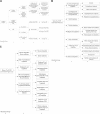Proposed classification of lymphoid neoplasms for epidemiologic research from the Pathology Working Group of the International Lymphoma Epidemiology Consortium (InterLymph)
- PMID: 17389762
- PMCID: PMC1924473
- DOI: 10.1182/blood-2006-11-051672
Proposed classification of lymphoid neoplasms for epidemiologic research from the Pathology Working Group of the International Lymphoma Epidemiology Consortium (InterLymph)
Abstract
Recent evidence suggests that there is etiologic heterogeneity among the various subtypes of lymphoid neoplasms. However, epidemiologic analyses by disease subtype have proven challenging due to the numerous clinical and pathologic schemes used to classify lymphomas and lymphoid leukemias over the last several decades. On behalf of the International Lymphoma Epidemiology Consortium (InterLymph) Pathology Working Group, we present a proposed nested classification of lymphoid neoplasms to facilitate the analysis of lymphoid neoplasm subtypes in epidemiologic research. The proposed classification is based on the World Health Organization classification of lymphoid neoplasms and the International Classification of Diseases-Oncology, Third Edition (ICD-O-3). We also provide a translation into the proposed classification from previous classifications, including the Working Formulation, Revised European-American Lymphoma (REAL) classification, and ICD-O-2. We recommend that epidemiologic studies include analyses by lymphoma subtype to the most detailed extent allowable by sample size. The standardization of groupings for epidemiologic research of lymphoma subtypes is essential for comparing subtype-specific reports in the literature, harmonizing cases within a single study diagnosed using different systems, as well as combining data from multiple studies for the purpose of pooled analysis or meta-analysis, and will probably prove to be critical for elucidating etiologies of the various lymphoid neoplasms.
Figures

References
-
- Ferlay J, Bray F, Pisani P, Parkin D. IARC CancerBase No. 5. Lyon, France: IARC Press; 2004. GLOBOCAN 2002: cancer incidence, mortality and prevalence worldwide. version 2.0.
-
- Rothman N, Skibola CF, Wang SS, et al. Genetic variation in TNF and IL10 and risk of non-Hodgkin lymphoma: a report from the InterLymph Consortium. Lancet Oncol. 2006;7:27–38. - PubMed
-
- Aisenberg AC. Historical review of lymphomas. Br J Haematol. 2000;109:466–476. - PubMed
-
- Weisenburger DD. Pathological classification of non-Hodgkin's lymphoma for epidemiological studies. Cancer Res. 1992;52(19) Suppl:5456s–5462s. - PubMed
Publication types
MeSH terms
Grants and funding
LinkOut - more resources
Full Text Sources
Medical

